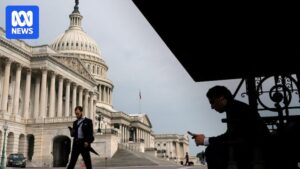
The federal government finds itself at a crossroads as it grapples with the regulation of artificial intelligence (AI). With various stakeholders pulling in different directions, the path forward remains uncertain. On one side, AI companies are lobbying for fewer restrictions, while creators and unions call for tighter controls to protect jobs and intellectual property. Meanwhile, the infrastructure supporting AI development continues to grow, raising concerns over energy consumption and economic feasibility.
This debate unfolds as significant investments pour into IT infrastructure, driven by the promise of AI’s potential. However, the business case for AI remains speculative, with the possibility of it becoming more monetizable than current search engines. The risk of an AI bubble looms, with potential repercussions for financial markets. The government’s challenge lies in defining the policy problem, as the impacts of AI are expected to be vast and multifaceted, potentially surpassing those of social media and search engines.
Understanding the Policy Dilemma
The complexity of AI regulation is compounded by the uncertainty surrounding its impacts. As AI technologies evolve, they could redefine interactions between individuals and the world, create disinformation, and replace personal and professional relationships on a large scale. The difficulty in predicting these outcomes mirrors past challenges with social media regulation, which governments are still struggling to address effectively.
In August, Mordy Bromberg, head of the Australian Law Reform Commission, emphasized the need for a proactive approach to AI regulation. He advocated for a comprehensive assessment of AI’s regulatory challenges across the economy, rather than isolated debates driven by industrial interests. However, his call for action has yet to gain traction.
Expert Perspectives on AI’s Future
Opinions on AI’s future and its implications for the workforce vary widely. Andrew Leigh, a prominent figure in the discussion, recently highlighted AI’s role in a “progressive productivity agenda,” citing increased demand for radiologists as an example of AI complementing, rather than replacing, jobs. Yet, other experts warn of a potential “jobs hecatomb” as more advanced AI technologies emerge, threatening white-collar employment and disrupting financial systems.
“The unpredictability of AI’s impact on jobs and the economy necessitates a risk management approach by governments,” said a leading tech analyst.
Proposing a Solution: An Advisory Panel
To address the unknown risks associated with AI, the government could establish an advisory panel comprised of experts from various fields. This panel would monitor AI’s societal and economic impacts, providing regular reports to the government and flagging significant issues for further investigation. Such a panel would serve as an early warning system, allowing the government to respond more swiftly to emerging challenges.
The proposed panel would include economists, scientists, engineers, investors, and legal experts, ensuring a comprehensive understanding of AI’s multifaceted nature. While assembling such a group may be challenging, it offers a low-cost solution to a complex problem, potentially sparing the government from repeating past regulatory missteps.
Looking Forward: Managing AI’s Risks
Effective AI regulation requires a nuanced understanding of its potential impacts on society and the economy. By adopting a proactive risk management approach, the government can better navigate the uncertainties of AI development. The establishment of an advisory panel represents a pragmatic step towards achieving this goal, providing the government with the insights needed to make informed policy decisions.
As AI continues to evolve, the stakes are high. The government’s ability to regulate AI effectively will have far-reaching consequences, shaping the future of technology, employment, and societal norms. By acting now, policymakers can help ensure that AI’s benefits are maximized while minimizing its potential harms.






